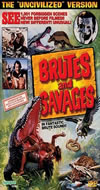 
1977 - 107m. 
|
The mondo movie (or shockumentary) is a strange beast. It is a bizarre subgenre that many horror fans have had some experience with as most of us can remember seeking out Faces of Death in our teens. I find that I always have a lurid interest in them that quickly fades away once I am about thirty minutes into a title. This film was no exception and the abundance of animal death resulted in numerous images that I wished I could unsee. Nevertheless, I plodded onwards through this rare American entry into the genre and while I was trying to suppress the pit in my stomach for much of the running time, I did derive some entertainment from the strange ineptness of it all.
Brutes and Savages purports to be a documentary conducted by the Arthur Davis expedition and their exploration of Africa, Bolivia, and Peru. What follows is a series of mostly staged scenes that show a variety of both rituals of various tribes and the unpleasant side of the animal kingdom. We start in Africa where we see a tribe of body-painted men engage in battle after one of them violates the chief's daughter. After an unanticipated goat decapitation, we see the equivalent of a primitive version of "ghetto brawls" that didn't do much for me. This is followed by one of the most entertaining sequence in the film where we are supposedly shown a manhood initiation ceremony where a few young lads cross a crocodile-infested river to metaphorically cross into manhood. Of course, one of them gets mauled by one of the reptiles. This is the scene that is the best known from the film as it is obviously staged, continuity errors abound, and the crocodile as well as the severed limbs look like they were made out of paper mache by a kindergarten class.
From Africa, the film moves to South America where we begin with a depressing look at what the narrator calls a 'death village' which is a poor village with a bunch of malnourished children. From there, we see a turtle wedding ceremony where a turtle gets its throat-slit in a scene that is shorter but just as uncomfortable as the turtle scene in Cannibal Holocaust. The next big scene involves the slaughter of a llama (complete with its still beating heart dug out of its chest) that almost made me turn off the film and was one of those moments I wish I could erase from my brain. The film rounds out with some cocaine farmers, a stone-throwing battle, some brain surgery that rivals Saw III for gross-out value, a look at some pornographic pottery, and ends on a happy note (in the filmmaker's opinion) with some simulated bestiality involving a llama. Sprinkled throughout all of this mayhem is a variety of animal vs. animal killings featuring snakes, hawks, armadillos, and more.
Needless to say, I can't stand animal violence and had I known that this film would feature it to the extent it did, I would never have watched this. If these scenes were not in the film, I may have enjoyed it to some degree as the narration was often unintentionally funny. The fact that they kept reiterating that they were sneaking around with 'hidden' cameras while most of the footage was shot with close-ups and multiple angles was quite amusing. Davis himself was quite the character with silly looking hair and a terrible wardrobe. The best part of the whole thing, however, was the neo-disco music by Riz Ortolani who has scored countless Italian flicks including Cannibal Holocaust, Mondo Cane, and a variety of others.
If you are looking for a real documentary, stay away. If you love animals, stay away. If you have a weak stomach, stay away. If you are easily offended, stay away. If you can see the humour in the small print of the opening credits, you may get a kick out of this. It reads "all scenes whether actual or simulated represent actual truth". Yeah, right. (Josh Pasnak, 1/17/07)
Directed By: Arthur Davis.
Written By: Jenny Craven [Narration].
Starring: Arthur Davis, various animals and tribespeople.
|